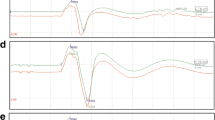Abstract
The spinal cords of 2-week-old kittens were tethered by fixing the end of the filum terminale to the lower sacrum, to study the effects of tethering and untethering on regional spinal cord blood flow (rSCBF), sensory-evoked potentials (SEPs) and clinical features. Progressive sensorimotor deficits and incontinence were observed in all the tethered cats. Cord tethering induced a reduction of rSCBF in the distal spinal cord close to the tethering (L 3) by 32% of the normal flow 2 weeks after tethering and by 67% 10 weeks after tethering. Untethering of the cord resulted in an increase of rSCBF, restoring it to the normal level in the group untethered 2 weeks after tethering, but rSCBF did not increase in the group untethered 8 weeks after tethering. The changes in SEPs were observed whenever rSCBF was below 14 ml/100 g per minute. Suppression of the early components of SEPs was observed 2 weeks after tethering and the components were progressively altered in amplitude and latency during the experimental period. It is assumed that early untethering can improve the spinal cord blood flow as well as the function of the cord.
Similar content being viewed by others
References
Anderson FM (1968) Occult spinal dysraphism. Diagnosis and management. J Pediatr 73:163–177
Branston NM, Symon L, Crockard HA, Juhasz (1974) Relationship between cortical evoked potential and local cortical blood flow following acute middle cerebral artery occlusion in the baboon. Exp Neurol 45:195–208
Breig A (1970) Overstretching of and circumscribed pathological tension in the spinal cord: a basic cause of symptoms in cord disorders. J Biomech 3:7–9
Chambers G, Eldred E, Eggett C (1972) Anatomical observations on the arterial supply to the lumbosacral spinal cord of the cat. Anat Rec 174:421–433
Dolan EJ, Tator CH, Transfeldt EE, Tafor CH, Simmons EH, Hughes KF (1980) The effect of spinal distraction on regional spinal cord blood flow in cats. J Neurosurg 53:756–764
Ducker TB, Salcman M, Lucas JT, Garrison WB, Perot PL (1978) Experimental spinal cord trauma. II. Blood flow, tissue oxygen, evoked potentials in both paretic and plegic monkey. Surg Neurol 10:64–70
Garceau GJ (1953) The filum terminale syndrome (the cord-traction syndrome). J Bone Joint Surg [Am] 35:711–716
Hoffman HJ, Hendrick EB, Humphreys (1976) The tethered spinal cord/ its protean manifestations, diagnosis and surgical correction. Child's Brain 2:145–155
James CCM, Lassman LP (1962) Spinal dysraphism. The diagnosis and treatment of progressive lesions in spina bifida occulta. J Bone Joint Surg [Br] 44:828–840
Jones PH, Love JG (1956) Tight filum terminale. Arch Surg 73:556–566
Kobrine AI, Doyle TF, Martins AN (1975) Local spinal cord blood flow in experimental traumatic myelopathy. J Neurosurg 42:144–149
Pasztor E, Symon L, Dorsch NWC (1973) The hydrogen clearance method in assessment of flow in cortex, white matter and deep nuclei of baboons. Stroke 4:556–567
Pool JL (1952) Spinal cord and local signs secondary to occult sacral meningocele in adults. Bull NY Acad Med 28:655–663
Sarwar M, Virapongse C, Bhimani S (1984) Primary tethered cord syndrome: a new hypothesis of its origin. AJNR 5:235–242
Senter HJ, Venes JL (1978) Altered blood flow and secondary injury in experimental spinal cord trauma. J Neurosurg 49:569–578
Thomas JE, Miller RH (1973) Lipomatous tumors of the spinal canal. Mayo Clin Proc 48:393–400
Till K (1969) Spinal dysraphism. A study of congenital malformation of the lower back. J Bone Joint Surg [Br] 51:415–422
Yamada S, Zinke DE, Sanders D (1981) Pathophysiology of “tethered cord syndrome”. J Neurosurg 54:494–503
Yashon D, Beatty RA (1966) Tethering of the conus medullaris within the sacrum. J Neurol Neurosurg Psychiatry 29:244–250
Author information
Authors and Affiliations
Rights and permissions
About this article
Cite this article
Kang, J.K., Kim, M.C., Dal Kim, S. et al. Effects of tethering on regional spinal cord blood flow and sensory-evoked potentials in growing cats. Child's Nerv Syst 3, 35–39 (1987). https://doi.org/10.1007/BF00707191
Issue Date:
DOI: https://doi.org/10.1007/BF00707191




